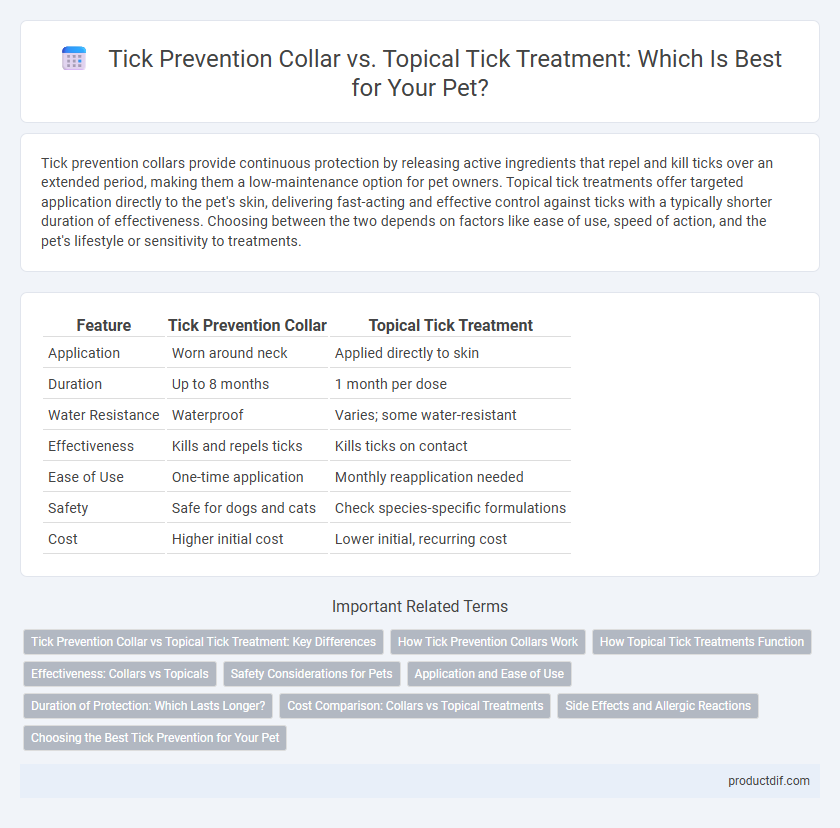Tick prevention collars provide continuous protection by releasing active ingredients that repel and kill ticks over an extended period, making them a low-maintenance option for pet owners. Topical tick treatments offer targeted application directly to the pet's skin, delivering fast-acting and effective control against ticks with a typically shorter duration of effectiveness. Choosing between the two depends on factors like ease of use, speed of action, and the pet's lifestyle or sensitivity to treatments.
Table of Comparison
| Feature | Tick Prevention Collar | Topical Tick Treatment |
|---|---|---|
| Application | Worn around neck | Applied directly to skin |
| Duration | Up to 8 months | 1 month per dose |
| Water Resistance | Waterproof | Varies; some water-resistant |
| Effectiveness | Kills and repels ticks | Kills ticks on contact |
| Ease of Use | One-time application | Monthly reapplication needed |
| Safety | Safe for dogs and cats | Check species-specific formulations |
| Cost | Higher initial cost | Lower initial, recurring cost |
Tick Prevention Collar vs Topical Tick Treatment: Key Differences
Tick prevention collars provide continuous protection by slowly releasing insecticides over weeks, making them highly effective for long-lasting defense against ticks. Topical tick treatments offer targeted application directly on the pet's skin, offering immediate but shorter-term protection that requires monthly reapplication. The collar's advantage lies in consistent, widespread coverage, whereas topical treatments allow customization based on the pet's specific needs and tick exposure level.
How Tick Prevention Collars Work
Tick prevention collars release active ingredients that repel and kill ticks on contact, creating a protective barrier around the pet's neck. These collars gradually dispense pesticides such as flumethrin or amitraz, providing long-lasting protection for up to 8 months. Unlike topical treatments, collars offer continuous defense without the need for frequent reapplication, making them convenient for sustained tick control.
How Topical Tick Treatments Function
Topical tick treatments function by releasing active ingredients that spread across a pet's skin and coat, creating a protective barrier that kills ticks on contact or within hours of infestation. These treatments often contain compounds like fipronil, permethrin, or selamectin, which disrupt the nervous system of ticks, preventing attachment and feeding. Unlike collars, topical treatments provide targeted, fast-acting protection that can be applied monthly for continuous defense against tick-borne diseases.
Effectiveness: Collars vs Topicals
Tick prevention collars provide continuous protection by releasing insecticides slowly over time, ensuring long-lasting defense against tick infestations. Topical tick treatments offer targeted, fast-acting effectiveness by killing ticks upon application or contact, but may require more frequent reapplication depending on the product's formulation. Studies indicate that collars maintain a steady level of protection for up to 8 months, while topical treatments often need monthly application, impacting overall convenience and sustained effectiveness.
Safety Considerations for Pets
Tick prevention collars provide continuous protection with controlled-release formulas designed to minimize toxicity risks, making them a safer long-term option for pets prone to frequent outdoor exposure. Topical tick treatments require careful application to avoid skin irritation and accidental ingestion, posing a higher risk for pets with sensitive skin or those who groom excessively. Choosing between collars and topical treatments depends on pet behavior, skin sensitivity, and the specific tick-borne disease risk in the environment.
Application and Ease of Use
Tick prevention collars provide continuous protection by slowly releasing active ingredients over time, making them low-maintenance and convenient for pet owners. Topical tick treatments require direct application to the pet's skin, usually between the shoulder blades, which may be messier and requires reapplication every few weeks for sustained effectiveness. Collars are ideal for pets that dislike frequent handling, while topical treatments allow for targeted dosing but demand more frequent attention.
Duration of Protection: Which Lasts Longer?
Tick prevention collars typically provide continuous protection for up to 8 months by slowly releasing active ingredients, making them ideal for extended tick season coverage. Topical tick treatments generally last between 4 to 6 weeks per application, requiring monthly reapplication to maintain efficacy. Choosing between the two depends on the desired duration of protection and convenience for long-term tick control in pets.
Cost Comparison: Collars vs Topical Treatments
Tick prevention collars generally offer a more cost-effective solution for long-term use compared to topical tick treatments, with collars priced between $15 and $40 lasting up to 6 months. Topical treatments typically cost $10 to $20 per dose and require monthly reapplication, resulting in higher annual expenses. Considering both upfront and maintenance costs, collars provide better value by reducing the frequency of purchases and ongoing application efforts.
Side Effects and Allergic Reactions
Tick prevention collars often cause fewer systemic side effects compared to topical tick treatments, which may lead to localized skin irritation, redness, or hair loss at the application site. Allergic reactions to collars are usually rare but can include rash or itching due to material sensitivity, whereas topical treatments carry a higher risk of hypersensitivity responses such as swelling or excessive scratching. Pet owners should monitor their animals closely for adverse reactions regardless of the chosen tick prevention method and consult veterinarians to select the safest option based on the pet's health history.
Choosing the Best Tick Prevention for Your Pet
Tick prevention collars provide long-lasting protection by slowly releasing active ingredients, making them ideal for pets with outdoor exposure. Topical tick treatments offer targeted application and rapid effectiveness but require regular reapplication every 30 days for continuous coverage. Choosing the best tick prevention depends on your pet's lifestyle, health considerations, and convenience preferences to ensure optimal safety against tick-borne diseases.
Tick Prevention Collar vs Topical Tick Treatment Infographic

 productdif.com
productdif.com